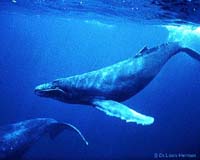| . |  |
. |
Canterbury, New Zealand (UPI) Apr 22, 2011 Humpback whales have a mysteriously precise navigational skill that cannot be explained by known theories, New Zealand researchers say. Scientists at the University of Canterbury tracked 16 tagged whales by satellite as they migrated thousands of miles northwards from the South Atlantic and South Pacific and found that for days at a time the whales swam legs of their journey -- often more than 500 miles -- with unerring accuracy, the Sydney Morning Herald reported Wednesday. In spite of the effects of weather and ocean currents, most of the whales maintained an almost dead-straight course, deviating by less than 1 degree, the researchers said. "Such remarkable directional precision is difficult to explain by established models of directional orientation," Canterbury researcher Travis Horton wrote in the Royal Society journal Biology Letters. Most long-distance migrating animals are thought to navigate using a compass based either on the Earth's magnetic field or the position of the sun, but neither method can account for the extraordinary navigational ability of humpback whales, the scientists said. "It seems unlikely that individual magnetic and solar orientation cues can, in isolation, explain the extreme navigational precision achieved by humpback whales," the study said. "The relatively slow movements of humpback whales, combined with their clear ability to navigate with extreme precision over long distances, present outstanding opportunities to explore alternative mechanisms of migratory orientation based on empirical analysis of track data," it concluded.
Share This Article With Planet Earth
Related Links Follow the Whaling Debate
 Humpback Whale Songs Spread Eastward Like The Latest Pop Tune
Humpback Whale Songs Spread Eastward Like The Latest Pop TuneWashington DC (SPX) Apr 18, 2011 Humpback whales have their own version of the hit single, according to a study reported online on April 14th in Current Biology, a Cell Press publication. At any given time within a population, male humpbacks all sing the same mating tune. But the pattern of the song changes over time, with the new and apparently catchy versions of the song spreading repeatedly across the ocean, almost alw ... read more |
|
| The content herein, unless otherwise known to be public domain, are Copyright 1995-2010 - SpaceDaily. AFP and UPI Wire Stories are copyright Agence France-Presse and United Press International. ESA Portal Reports are copyright European Space Agency. All NASA sourced material is public domain. Additional copyrights may apply in whole or part to other bona fide parties. Advertising does not imply endorsement,agreement or approval of any opinions, statements or information provided by SpaceDaily on any Web page published or hosted by SpaceDaily. Privacy Statement |